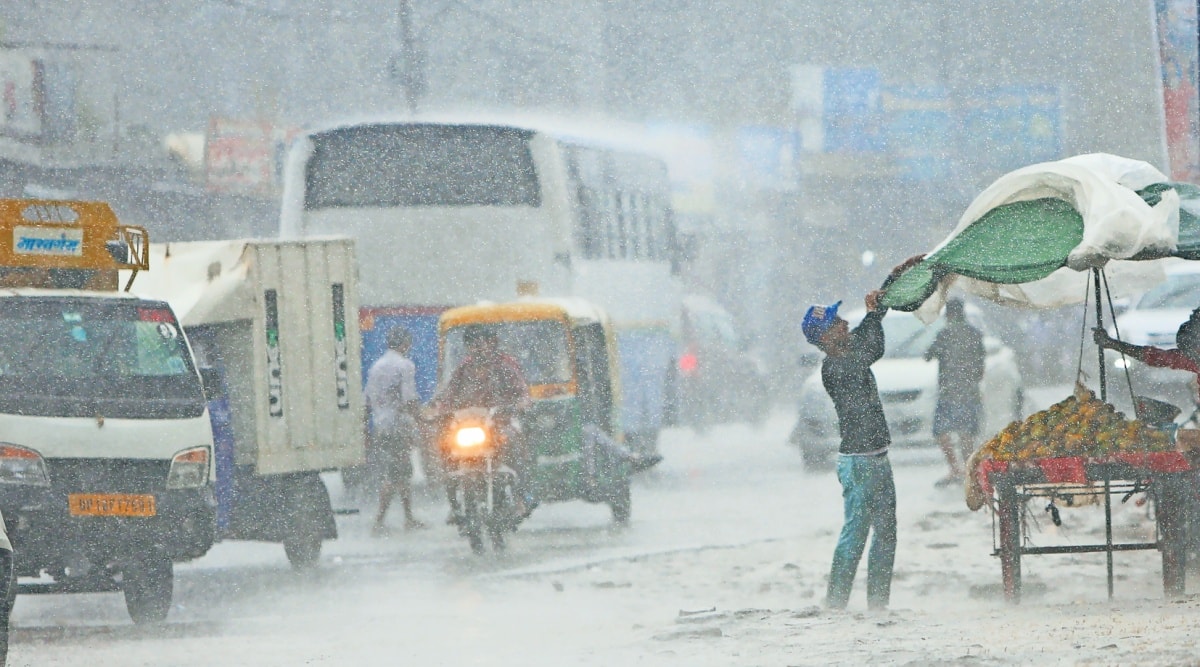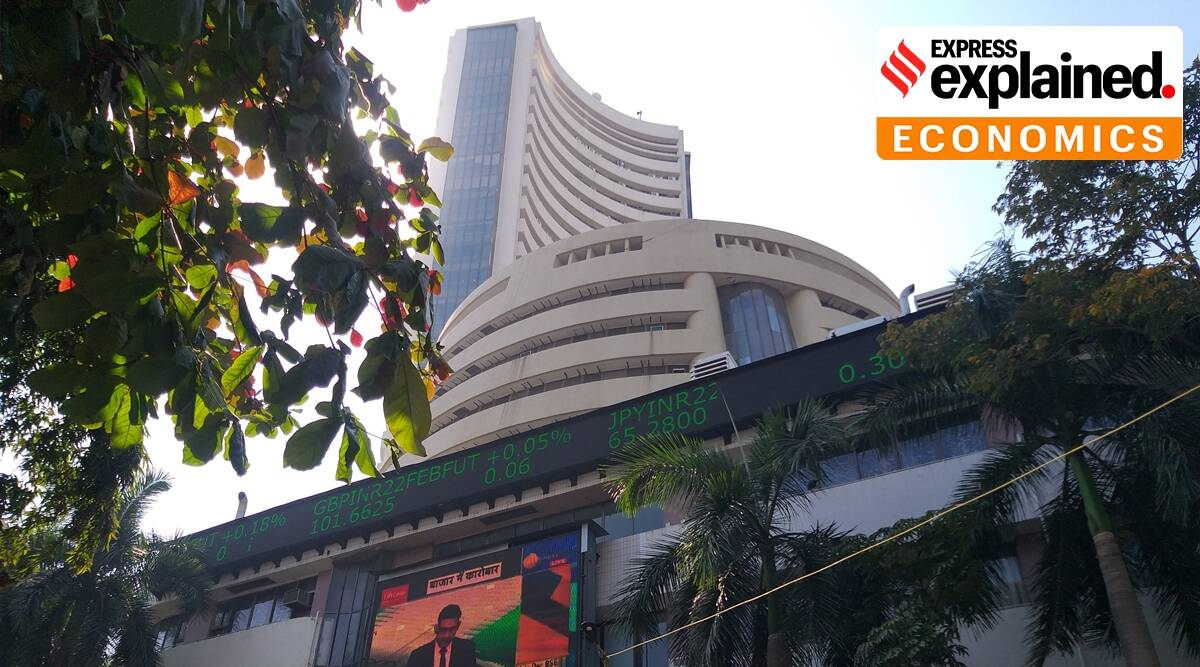FOR ANKIT Kumar, 21, a state-ranked hurdler, life is an unending race against time. When not trying to beat his coach’s stop-watch at the Jawaharlal Nehru (JLN) Stadium, he is trying to stick to the ETA while delivering orders for a quick-commerce grocery app.
The son of a welder from Kundli in Haryana, Ankit stays in a windowless room at Kotla Mubarakpur, an urban slum not far from JLN. It’s a space that he shares with four others. Ankit’s roommates and close to 1,000 other athletes at Kotla lead a similar double-life. They fund their track-and-field dreams by working as gig workers — the flexibility and independence of the industry allowing them time to move between two very distinct worlds.

“We try to complete a few orders in the morning before the afternoon sun comes out and we continue later after evening practice. I deliver from 8 pm to 2 am on most days. It affects my post-practice recovery but option kya hai (there’s no choice),” says Ankit.
As they flock to Kotla from villages in states neighbouring Delhi, many of these youngsters exercise that only “option” they have: undertake the journey to Delhi, hoping the Capital will give them a chance to make it in the impossibly competitive world of track and field. Back home, where there are no coaching and training facilities worth talking of, their dreams run into a series of obstacle courses. For instance, the West UP town of Meerut, known as a sports manufacturing hub, doesn’t have a single synthetic track for training. JLN, though poorly maintained, with a patched-up track in the main arena and a practice track that’s not fit for elite training, is still the best option for many of these youngsters. They know that they are on their own until they break into the national level, which is when they can hope for some kind of state support.
Kotla and its thousand dreams
When Ankit came to Delhi in 2018, he knew where to go. On the athletics circuit, he had heard that Kotla Mubarakpur was the ideal place for those wanting to follow in the footsteps of Neeraj Chopra, India’s first-ever Olympic track-and-field gold medallist. It’s Kotla Mubarakpur’s proximity to JLN and its budget spaces, unlike the more upmarket areas of Defence Colony or South Extension nearby, that draw Ankit and hundreds of others like him to the neighbourhood.

The area’s open drains, complex maze of bylanes and the unmissable ‘bad elements’ don’t make Kotla the ideal neighbourhood for those hoping to climb podiums. But as they keep saying around here, “option kya hai?”.
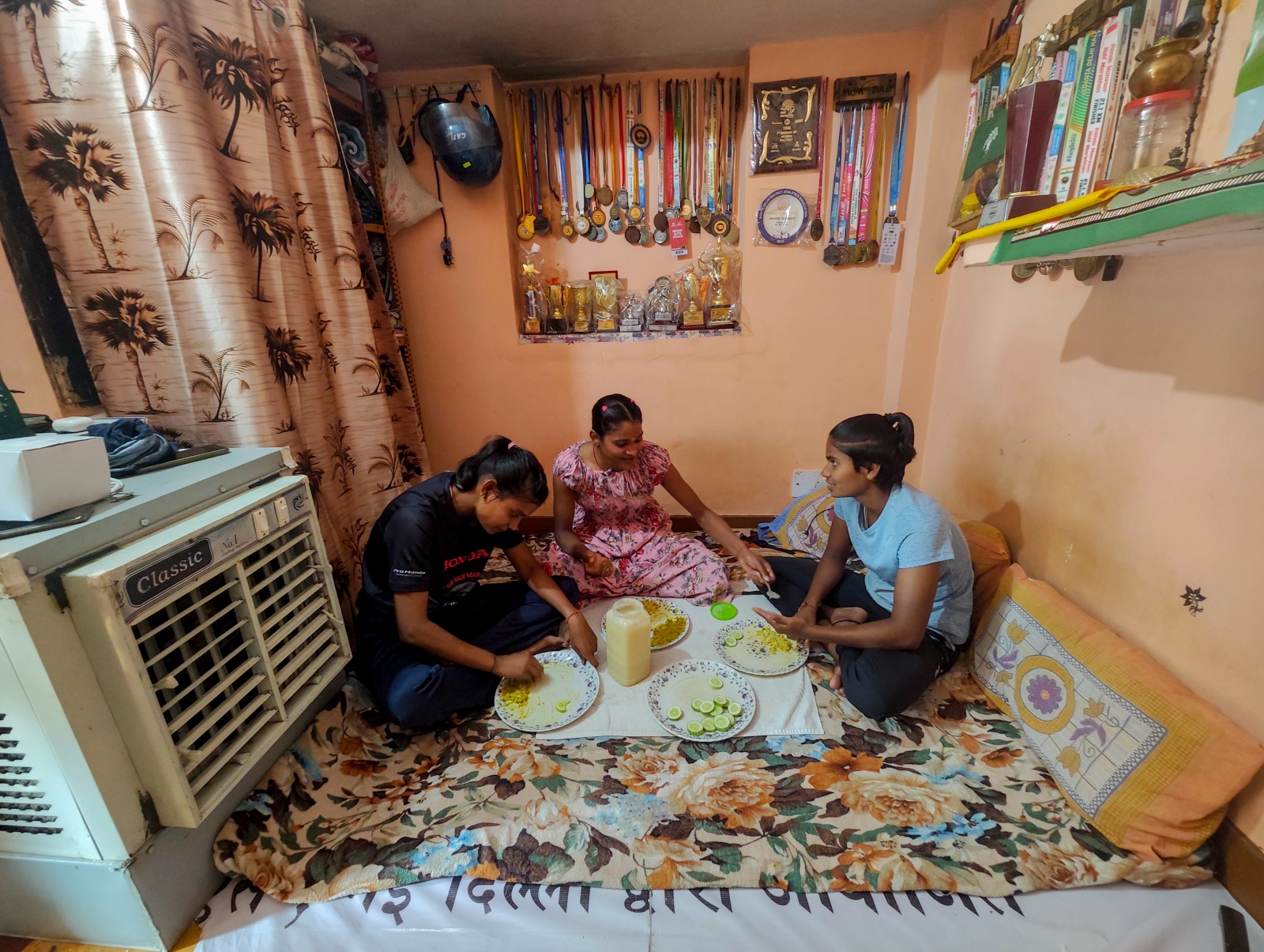 Sonam (centre), a steeplechase national record-holder from a village in Uttar Pradesh’s Bulandshahr district, in her rented room in Kotla Mubarakpur. (Express Photo by Abhinav Saha)
Sonam (centre), a steeplechase national record-holder from a village in Uttar Pradesh’s Bulandshahr district, in her rented room in Kotla Mubarakpur. (Express Photo by Abhinav Saha)
In one such lane lives youth steeplechase national record-holder Sonam. The daughter of a brick kiln labourer from a Dalit settlement in Hurthala village in Bulandshahr district of Uttar Pradesh, Sonam made Kotla her home when she was 15. She is now 19 and has grown used to the place. “Yahan ki mehak hi alag hai, na (This place has a distinct scent doesn’t it)?,” she jokes, embarrassed by the foul smell emanating from the litter outside her room.
While Sonam, with multiple junior national titles, is among the more accomplished athletes, most of the Kotla athletes are still trying to find their feet. A good number of them are state medallists and regularly take part in private running events for prize money. Sonam had to work as a delivery agent until she broke Parul Chaudhary’s decade-old 200m Youth national record at the Khelo India Youth Games last year. She is now part of the Khelo India scholarship, where she receives a monthly stipend of Rs 10,000.
“This is one of the better lanes to live in,” assures Sonam’s coach Sanjeev. He smiles and adds: “Option kya hai?”. Sanjeev speaks for most of the athletes who have made Kotla their home. Their shared sporting dreams have given Delhi’s urban landscape another pocket of aspiration. If North Delhi’s Mukherjee Nagar is where the country’s UPSC aspirants head to and Mandi House attracts theatre artistes, Kotla Mubarakpur has now emerged as a village of sporting strugglers.
The Mukherjee Nagar of sports
Just as coaching classes and photocopy kiosks mushroom around education hubs, auxiliary businesses catering to the athletes fight for space in this densely-populated area. The neighbourhood’s fruit juice shops, kiosks selling boiled eggs, sports apparel outlets and chemist shops are mostly frequented by fit and lean boys and girls.
Naveen Kumar is one such beneficiary of the Kotla-JLN ecosystem. His clothes store, which he has been running for over seven years, supplies “foreign reject” apparel to athletes. Hand-me-down domestic branded clothes also make their way to Naveen’s collection. If bargained right, a T-shirt can be bought for as less as Rs 50. Stores such as these are lifesavers for athletes living on a shoestring budget.
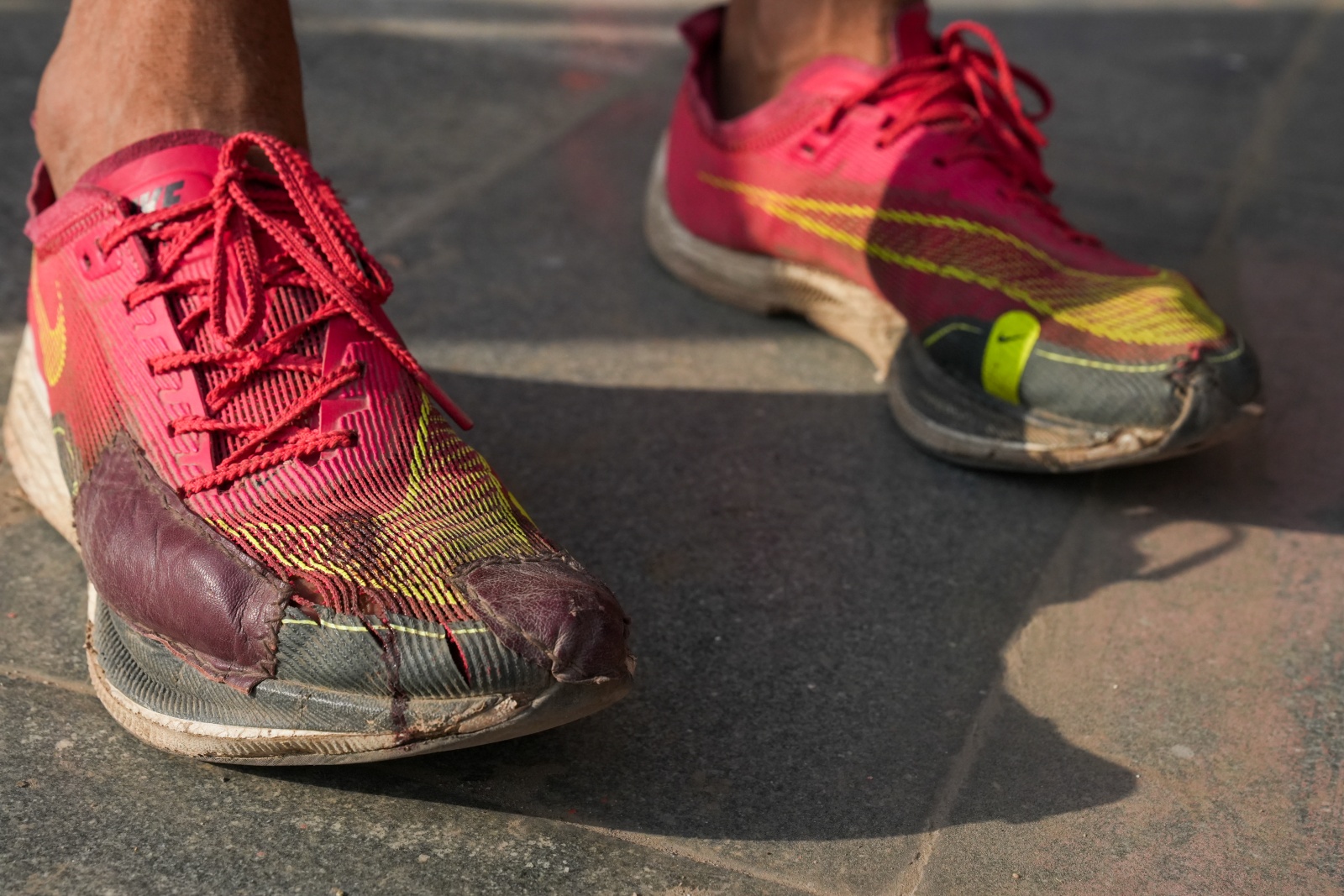 If North Delhi’s Mukherjee Nagar is where the country’s UPSC aspirants head to and Mandi House attracts theatre artistes, Kotla Mubarakpur has now emerged as a village of sporting strugglers. (Express Photo by Abhinav Saha)
If North Delhi’s Mukherjee Nagar is where the country’s UPSC aspirants head to and Mandi House attracts theatre artistes, Kotla Mubarakpur has now emerged as a village of sporting strugglers. (Express Photo by Abhinav Saha)
“Athletes tell me in advance what kind of apparel they need and I sort it from the pile of clothes that arrive,” Naveen explains.
“I don’t know where they get these clothes from. Once we got a jersey of some school in Australia,” says Sonam’s coach Sanjeev.
Steeplechaser Mohammed Abbas does have issues with Kotla’s poorly ventilated rooms and dingy lanes, but is happy to adjust for the convenience that comes with living in the area.
“You will get everything here and for a reasonable price. There are good food options and they all treat athletes nicely,” says the 19-year-old state medallist who works part-time as a BPO call agent.
Manoj Kumar, co-owner of the popular Kailash restaurant, says 60 per cent of their revenue comes from sportspersons. “I can’t give you the number of athletes visiting each day but if you come this evening, you will find them taking up all the tables. There is hardly any space left for others,” says the manager.
For most athletes, though, eating at a budget dhaba is a luxury so on most days, they cook their meals. In Ankit’s room, the responsibilities have been divided. “Two are in charge of cooking, one has to do the cleaning and we also have one person whose job is to run errands (from the third floor),” explains Ankit’s roommate, Ashish.
Rooms without fans and a ticking body clock
The rent for a single room, shared by three or more athletes, ranges from Rs 3,000 to 6,000. Azad Gautam, a middle-distance runner who had to go on a hunger strike to persuade his family to let him come to Delhi, shares a room with three others. The room doesn’t have a ceiling fan and Delhi’s unforgiving summer months have begun to kick in. “The budget is a little tight this month. We will see if we can get a fan soon,” he says. “At least this area has some sunlight; some athletes live in areas where you can’t tell if it is night or day,” adds steeplechaser Abbas, who lives on the floor above Azad’s.
Azad has seen worse — his room in Kotla Mubarakpur is an upgrade from his home in Bulandshahr. “Barish mein chhath tapakti thi gaon mein (At our village home, the roof would leak during the rains). Until my elder brother found a job, we didn’t have enough for three proper meals. Woh ek sangharsh tha, aab ye ek sangharsh hai (that was one struggle, this is another),” says Azad, who moved to Delhi early this year.
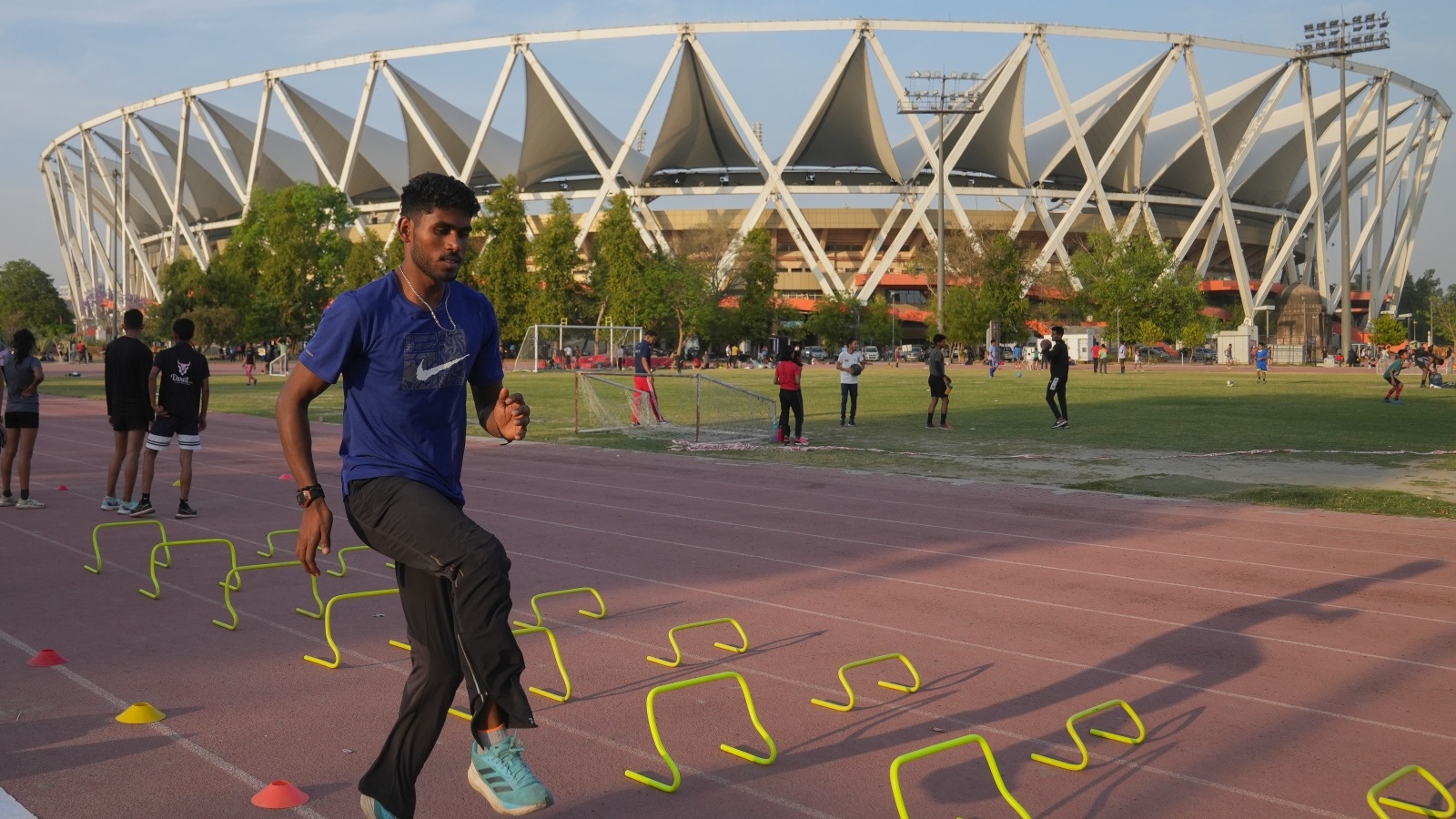 Ankit Kumar, who works as delivery boy, during a practice session at JLN Stadium. (Express Photo by Abhinav Saha)
Ankit Kumar, who works as delivery boy, during a practice session at JLN Stadium. (Express Photo by Abhinav Saha)
The “sangharsh” is relentless. With every passing year, the pressure from family to quit and take up a job keeps mounting.
Abbas, who has been trying to win a national-level medal for over five years, compares the lives of Kotla’s athletes to those of UPSC aspirants.
“Everything is temporary, tension is permanent. Every day before going to bed, doubts creep in. Every morning when we wake up, there is pressure to achieve something. Athletes have a very short career. I know I have very little time left,” says the 18-year-old.
Since most athletes are in their early 20s, they know they need to make a breakthrough quickly. They have to make the most of their 20s when their bodies are at peak fitness levels. “We know that we have to get our breakthrough before we turn 28-29. There are many senior athletes at JLN who are still hoping to bag their first national medal. It is tough,” says Abbas.
A medal at the Athletics Federation of India’s national-level meets is the bare minimum these youngsters have to achieve if they hope to ever turn pro. A medal at the nationals makes them eligible for applying in PSUs and other central government agencies. But a national medal in athletics is not easy. “Out of every 100 athletes who start off, only five will eventually be able to make a career out of it. We know this fact but yet we give it everything we have got. We athletes are a little crazy but that’s also what pushes us,” says Abbas.
There’s also the stress of societal and family pressure to “settle down”. “If I had still been in my village, my parents would have got me married off. My dreams of representing India would have been put to rest. But now that I have come here and earned a name for myself, the mindset of people in my village is changing,” says Sonam.
Kanta Prasad, who bagged two medals in long-distance running at the Delhi state meet this year, ran away from his home in Hamirpur district of UP in 2017 to escape marriage. After working in Ghaziabad as an office boy for a few years, he decided he had had enough. “I walked up to an auto and asked him to drop me off at the best athletics stadium in the region. He said it would cost me Rs 150 and dropped me at JLN. I had only seen JLN in photos and was mesmerised by what I saw. Those canopies at the main stadium gave it such a grand look,” he recalls. Kanta now works at a juice stall at JLN’s Gate No.1. He can’t afford a room at Kotla yet so sleeps on top of a kiosk in the open.
Then there is sprinter Mohammed Airaf, who also doubles as the hairstylist of most of the JLN athletes. The Moradabad resident has been a full-time barber since he was 10. After a rigorous day at the stadium, he barely gets any rest since the 19-year-old has to rush to the salon he works at in Kotla on a “50/50 deal” — he gets to keep half of his daily earnings; the other half goes to the owner in lieu of using the salon’s facilities.
“I didn’t know he was a barber when one of my students brought him to train under me. He is still young but has a lot of hunger to do well. For now, his cutting skills are better than running,” says Delhi state chief coach Dinesh Rawat, who is now a regular customer at Airaf’s salon.
Amidst all these struggles, sports remains the only balm. The hours spent slogging at the stadium remain their only escape. Abbas sums it up: “When we leave Kotla’s dingy area and enter the stadium it’s like jahannum ki aag se nikal kar jannat me agaye (We have escaped the fires of hell and reached heaven”.
After all, option kya hai.





 Sonam (centre), a steeplechase national record-holder from a village in Uttar Pradesh’s Bulandshahr district, in her rented room in Kotla Mubarakpur. (Express Photo by Abhinav Saha)
Sonam (centre), a steeplechase national record-holder from a village in Uttar Pradesh’s Bulandshahr district, in her rented room in Kotla Mubarakpur. (Express Photo by Abhinav Saha) If North Delhi’s Mukherjee Nagar is where the country’s UPSC aspirants head to and Mandi House attracts theatre artistes, Kotla Mubarakpur has now emerged as a village of sporting strugglers. (Express Photo by Abhinav Saha)
If North Delhi’s Mukherjee Nagar is where the country’s UPSC aspirants head to and Mandi House attracts theatre artistes, Kotla Mubarakpur has now emerged as a village of sporting strugglers. (Express Photo by Abhinav Saha) Ankit Kumar, who works as delivery boy, during a practice session at JLN Stadium. (Express Photo by Abhinav Saha)
Ankit Kumar, who works as delivery boy, during a practice session at JLN Stadium. (Express Photo by Abhinav Saha)



